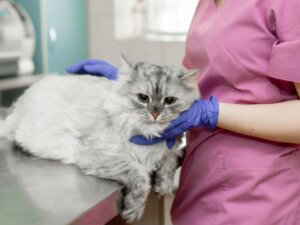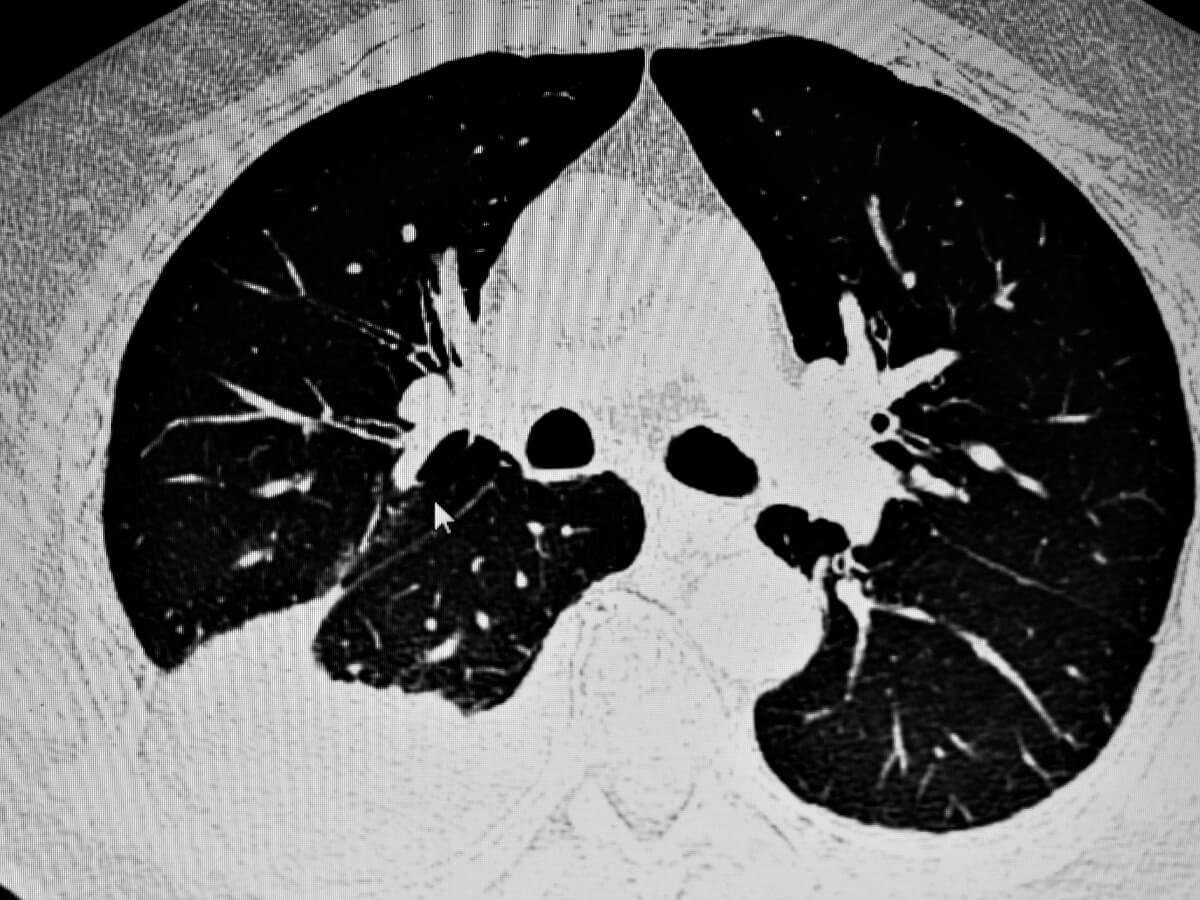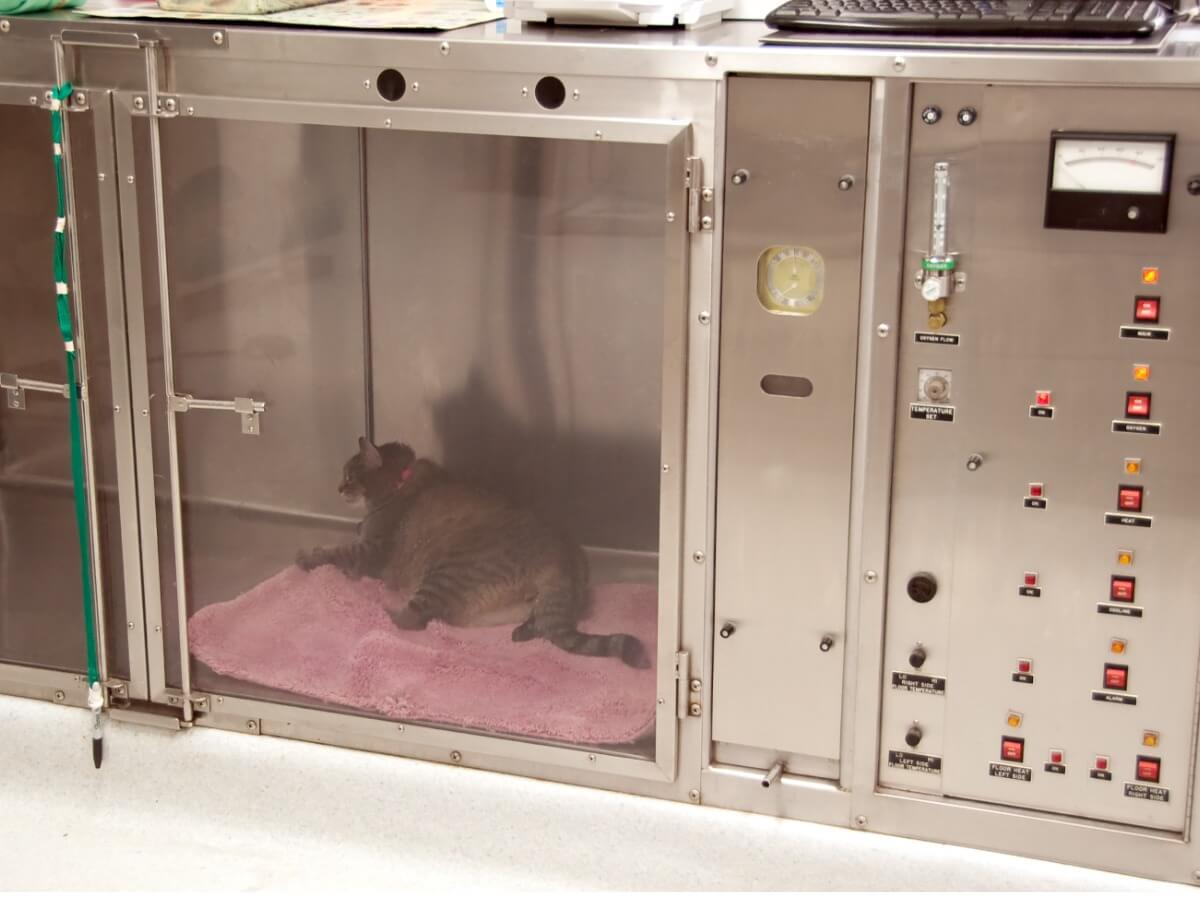Pleural Effusion in Cats: Causes, Diagnosis and Treatment


Written and verified by the biologist Samuel Sanchez
Pleural effusion in cats is a condition that causes an excessive amount of fluid to accumulate in the pleural cavity, a space between the parietal pleura and the visceral pleura. In this disease, the conflicting fluid isn’t inside the lungs, but, rather, in the space that protects them.
The prognosis of this pathology is highly variable and depends entirely on the underlying cause of the pleural effusion. If you want to know how to detect this condition in time in felines, read on.
What’s pleural effusion in cats?
The pleural cavity is the space between the visceral and parietal pleura, serous membranes whose function is to cover the surface of the lungs and the internal part of the thoracic cavity, respectively. A small amount of fluid in the pleural space allows lubrication between both membranes and ensures that respiratory movements can be produced properly.
Any process that causes an imbalance in internal fluid pressures, lymphatic drainage, or vascular integrity can result in a net accumulation of fluid in the pleural cavity. This pathological mechanism is known as pleural effusion. In cats, this occurs because too little fluid is reabsorbed from the affected area or, alternatively, because too much is produced.
Conditions that increase hydrostatic pressure in capillaries or reduce oncotic pressure can trigger pleural effusions in cats.

Symptoms
As indicated by the VCA Hospitals portal, pleural effusion in cats reduces the amount of space available for the expansion of the lungs in the chest when breathing. Therefore, most symptoms indicate that the feline has to work harder than before to get oxygen. Among the possible clinical signs, we highlight the following:
- Continuous coughing and shortness of breath.
- An increase in the number of breaths per minute. The normal respiratory rate at rest is 15 to 30 breaths per minute. If the cat shows a sustained increase, it’s possible that it has a problem in the lung or heart area.
- Atypical positions. The cat may change positions constantly to try to breathe better.
- Breathing with the mouth open.
- Blue or purple color of the mucous membranes, especially in the area of the nose and gums. This clinical sign is known as cyanosis and shows a lack of blood flow to the tissues.
- Exercise intolerance, loss of activity, and poor appetite.
Causes of pleural effusion in cats
As we’ve already said, many different conditions can cause an imbalance in the absorption and production of fluids in the pleural cavity. Next, we’ll show you the most common causes of pleural effusion in cats.
Feline pyothorax
The presence of septic exudate in the pleural cavity is called pyothorax. In other words, pus accumulates in this space from a bacterial infection or the presence of foreign bodies. The infection that causes this condition can be through the blood or from a very deep wound.
Feline chylothorax
This condition is characterized by the accumulation of chyle – lymphatic fluid – in the thoracic cavity. This condition can occur due to heart failure or direct trauma, but many of the conditions never have an underlying cause (idiopathic).
Heart failure
This is one of the most common causes of fluid accumulation in organs and inappropriate areas. When the heart isn’t working properly, it can encourage some fluids to settle and stagnate improperly. This can trigger pleural effusion in cats.
Diaphragmatic hernia
The diaphragm is the muscular separation between the thorax and the abdominal cavities that acts as a barrier and aids in breathing. When this structure is disturbed, the abdominal organs can move into the thoracic cavity. This defect can be congenital or acquired after a very severe physical trauma, but, in both variants, it’s capable of triggering a pleural effusion.
Other possible causes
We have presented you with four of the most common causes of this pathology in felines, but there are many more. Among them, we can highlight the following:
- Cancer: Malignant tumors in the lungs or pleura can cause effusions.
- Feline infectious peritonitis (FIP): As indicated by GEMFE, this condition is caused by a mutated feline coronavirus. Not all infected cats develop pleural effusion, but it’s still another cause.
- Hemorrhage: The consumption of toxic agents or a very strong blow can cause blood to accumulate inside the pleural cavity.
Diagnosis of pleural effusion in cats
According to professional studies, the first step in diagnosing feline pleural effusion is to pay special attention to their respiratory rate. The presence of strange sounds on auscultation, labored breathing, and a high number of breaths per minute are some of the clinical signs that evidence this disease.
Once a respiratory problem is suspected, x-rays are usually used to directly observe the animal’s medical condition. Ultrasounds can be helpful, especially when the amount of fluid accumulated in the pleural cavity is very low.
Thoracentesis — puncturing the chest wall to remove fluid — is used to detect the underlying cause of the pleural effusion. This diagnostic process will bring some immediate relief to the cat and will also help to find the problem after performing laboratory tests.
Treatment
Upon arrival at the clinic, the main objective is to stabilize the feline patient. To do this, the vet will automatically place the animal in an oxygen box, which allows the animal to obtain more O2 with less respiratory effort. This will allow its breathing to stabilize while they perform tests and plan the subsequent steps.
In some cases, thoracentesis is sufficient to remove conflicting excess fluid in the pleural cavity. In any case, in the most severe cases, the vet may insert a chest tube, which will constantly drain the fluid that their body is overproducing. This will make the cat breathe better, but doesn’t directly address the underlying cause.
The cause of pleural effusion in cats must be treated beyond respiratory stabilization. From removing a tumor to closing an internal wound, there are many possible approaches.

Prognosis of pleural effusion in cats
In almost all cases, stabilizing the feline patient is only the first step. After that, successive visits to the veterinarian will be necessary to diagnose the underlying cause of the pleural effusion.
Depending on the causative clinical entity, the prognosis can range from fatal to stabilization. In any case, this pathology usually shows that something is very wrong in one of the cat’s vital systems.
Pleural effusion in cats is a condition that causes an excessive amount of fluid to accumulate in the pleural cavity, a space between the parietal pleura and the visceral pleura. In this disease, the conflicting fluid isn’t inside the lungs, but, rather, in the space that protects them.
The prognosis of this pathology is highly variable and depends entirely on the underlying cause of the pleural effusion. If you want to know how to detect this condition in time in felines, read on.
What’s pleural effusion in cats?
The pleural cavity is the space between the visceral and parietal pleura, serous membranes whose function is to cover the surface of the lungs and the internal part of the thoracic cavity, respectively. A small amount of fluid in the pleural space allows lubrication between both membranes and ensures that respiratory movements can be produced properly.
Any process that causes an imbalance in internal fluid pressures, lymphatic drainage, or vascular integrity can result in a net accumulation of fluid in the pleural cavity. This pathological mechanism is known as pleural effusion. In cats, this occurs because too little fluid is reabsorbed from the affected area or, alternatively, because too much is produced.
Conditions that increase hydrostatic pressure in capillaries or reduce oncotic pressure can trigger pleural effusions in cats.

Symptoms
As indicated by the VCA Hospitals portal, pleural effusion in cats reduces the amount of space available for the expansion of the lungs in the chest when breathing. Therefore, most symptoms indicate that the feline has to work harder than before to get oxygen. Among the possible clinical signs, we highlight the following:
- Continuous coughing and shortness of breath.
- An increase in the number of breaths per minute. The normal respiratory rate at rest is 15 to 30 breaths per minute. If the cat shows a sustained increase, it’s possible that it has a problem in the lung or heart area.
- Atypical positions. The cat may change positions constantly to try to breathe better.
- Breathing with the mouth open.
- Blue or purple color of the mucous membranes, especially in the area of the nose and gums. This clinical sign is known as cyanosis and shows a lack of blood flow to the tissues.
- Exercise intolerance, loss of activity, and poor appetite.
Causes of pleural effusion in cats
As we’ve already said, many different conditions can cause an imbalance in the absorption and production of fluids in the pleural cavity. Next, we’ll show you the most common causes of pleural effusion in cats.
Feline pyothorax
The presence of septic exudate in the pleural cavity is called pyothorax. In other words, pus accumulates in this space from a bacterial infection or the presence of foreign bodies. The infection that causes this condition can be through the blood or from a very deep wound.
Feline chylothorax
This condition is characterized by the accumulation of chyle – lymphatic fluid – in the thoracic cavity. This condition can occur due to heart failure or direct trauma, but many of the conditions never have an underlying cause (idiopathic).
Heart failure
This is one of the most common causes of fluid accumulation in organs and inappropriate areas. When the heart isn’t working properly, it can encourage some fluids to settle and stagnate improperly. This can trigger pleural effusion in cats.
Diaphragmatic hernia
The diaphragm is the muscular separation between the thorax and the abdominal cavities that acts as a barrier and aids in breathing. When this structure is disturbed, the abdominal organs can move into the thoracic cavity. This defect can be congenital or acquired after a very severe physical trauma, but, in both variants, it’s capable of triggering a pleural effusion.
Other possible causes
We have presented you with four of the most common causes of this pathology in felines, but there are many more. Among them, we can highlight the following:
- Cancer: Malignant tumors in the lungs or pleura can cause effusions.
- Feline infectious peritonitis (FIP): As indicated by GEMFE, this condition is caused by a mutated feline coronavirus. Not all infected cats develop pleural effusion, but it’s still another cause.
- Hemorrhage: The consumption of toxic agents or a very strong blow can cause blood to accumulate inside the pleural cavity.
Diagnosis of pleural effusion in cats
According to professional studies, the first step in diagnosing feline pleural effusion is to pay special attention to their respiratory rate. The presence of strange sounds on auscultation, labored breathing, and a high number of breaths per minute are some of the clinical signs that evidence this disease.
Once a respiratory problem is suspected, x-rays are usually used to directly observe the animal’s medical condition. Ultrasounds can be helpful, especially when the amount of fluid accumulated in the pleural cavity is very low.
Thoracentesis — puncturing the chest wall to remove fluid — is used to detect the underlying cause of the pleural effusion. This diagnostic process will bring some immediate relief to the cat and will also help to find the problem after performing laboratory tests.
Treatment
Upon arrival at the clinic, the main objective is to stabilize the feline patient. To do this, the vet will automatically place the animal in an oxygen box, which allows the animal to obtain more O2 with less respiratory effort. This will allow its breathing to stabilize while they perform tests and plan the subsequent steps.
In some cases, thoracentesis is sufficient to remove conflicting excess fluid in the pleural cavity. In any case, in the most severe cases, the vet may insert a chest tube, which will constantly drain the fluid that their body is overproducing. This will make the cat breathe better, but doesn’t directly address the underlying cause.
The cause of pleural effusion in cats must be treated beyond respiratory stabilization. From removing a tumor to closing an internal wound, there are many possible approaches.

Prognosis of pleural effusion in cats
In almost all cases, stabilizing the feline patient is only the first step. After that, successive visits to the veterinarian will be necessary to diagnose the underlying cause of the pleural effusion.
Depending on the causative clinical entity, the prognosis can range from fatal to stabilization. In any case, this pathology usually shows that something is very wrong in one of the cat’s vital systems.
All cited sources were thoroughly reviewed by our team to ensure their quality, reliability, currency, and validity. The bibliography of this article was considered reliable and of academic or scientific accuracy.
- Pleural effusion in cats, VCA Hospitals. Recogido a 7 de julio en https://vcahospitals.com/know-your-pet/pleural-effusion-in-cats
- Peritonitis infecciosa felina (GEMFE). Recogido a 7 de julio en https://www.avepa.org/articulos/Peritonitis%20infecciosa%20felina%20(PIF).html
- Pleural Effusion in the Cat: A Practical Approach to Determining Aetiology. Recogido a 7 de julio en https://www.researchgate.net/publication/46034530_Pleural_Effusion_in_the_Cat_A_Practical_Approach_to_Determining_Aetiology
- Davies, C., & Forrester, S. D. (1996). Pleural effusion in cats: 82 cases (1987 to 1995). Journal of Small Animal Practice, 37(5), 217-224.
- Beatty, J., & Barrs, V. (2010). Pleural effusion in the cat: a practical approach to determining aetiology. Journal of Feline Medicine & Surgery, 12(9), 693-707.
- Ruiz, M. D., Vessières, F., Ragetly, G. R., & Hernandez, J. L. (2018). Characterization of and factors associated with causes of pleural effusion in cats. Journal of the American Veterinary Medical Association, 253(2), 181-187.
This text is provided for informational purposes only and does not replace consultation with a professional. If in doubt, consult your specialist.








